WASHINGTON POST
Particularly intriguing was the fact the grave on the Isles of Scilly contained both a sword — which would normally indicate a male burial during the Iron Age — and a bronze mirror, associated with female burials. The two have never been found together in a grave before, and “that combination of the two is what threw everyone in archaeology when it was first discovered,” Sarah Stark, a human skeletal biologist at Historic England and one of the study’s authors, said in an interview Thursday.
The remains themselves offered few clues — particularly as all that remained of the body was a dark stain where it had been placed and just 150 grams (5.3 ounces) of bone and teeth fragments. Scientists were able to establish the individual in the grave was aged between 20 and 25 when they died — but with so little of the skeleton left, it was not possible to identify the sex of the deceased or extract any DNA from the fragments.
Now, after analyzing proteins in the fragments of dental enamel found in the grave, an international team of scientists — which included scientists at the University of California at Davis and Harvard — say they have determined the body belonged to a woman — and, based on the available archaeological information, they believe she was a warrior leader.
Their findings, which they say provide a new insight into the possible societal structures of Iron Age Britain, were published in the peer-reviewed Journal of Archaeological Science: Reports on Thursday.
“Tooth enamel is the hardest and most durable substance in the human body,” Glendon Parker, professor of environmental toxicology at the University of California at Davis, explained in a statement shared by Historic England. He added that tooth enamel also contains proteins that can determine sex, and can survive longer than DNA.
“This allowed us to calculate a 96% probability that the individual was female. Given the degraded state of the bones, it’s remarkable to get such a strong result,” he said.
The next question was why the young woman had been granted such a rich burial. Based on the findings of other burial sites in the region and what is known about Iron Age society, the team believes that the objects placed in the grave “had meaning to her and served whatever role she had,” according to Stark.



